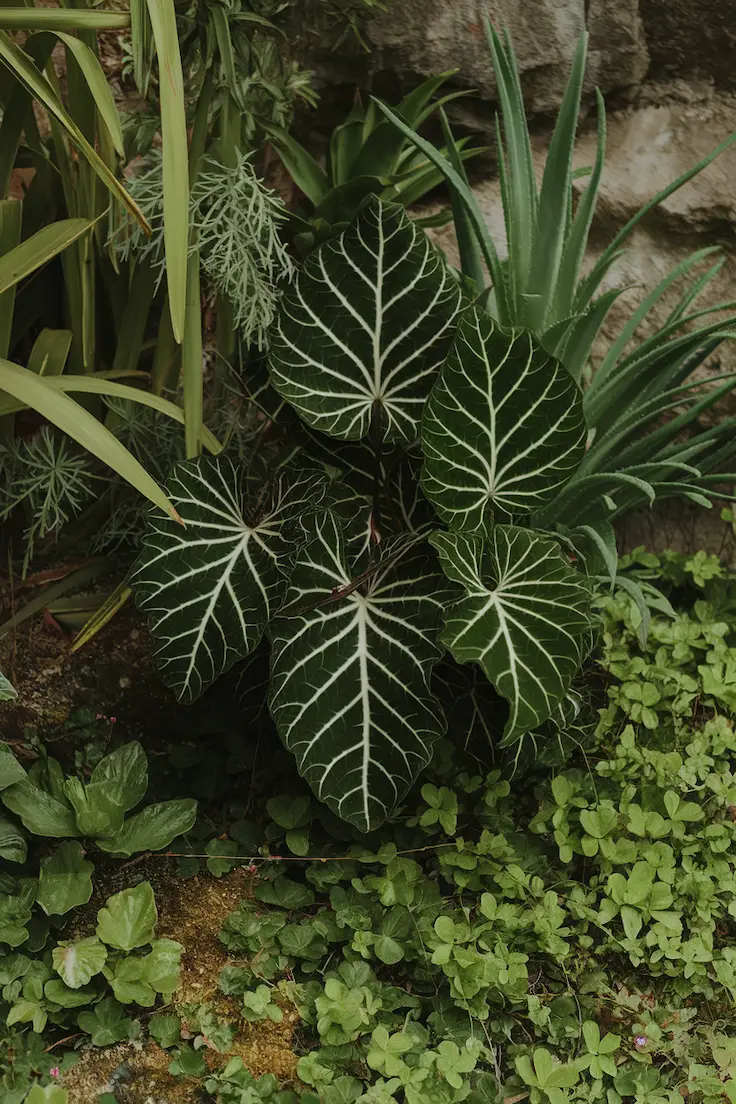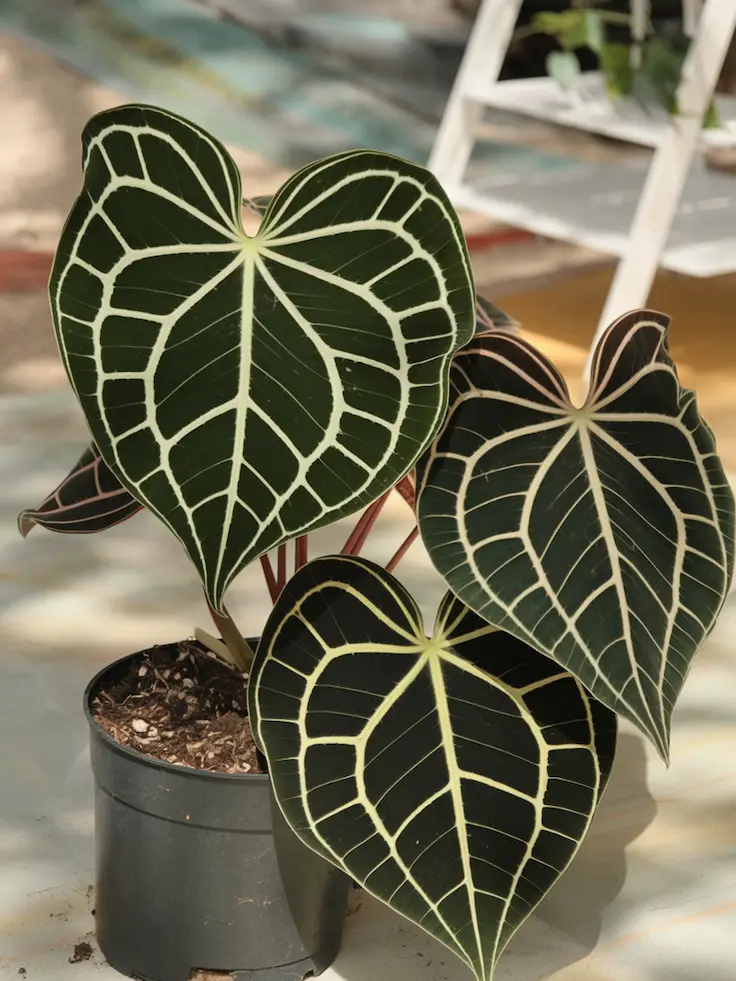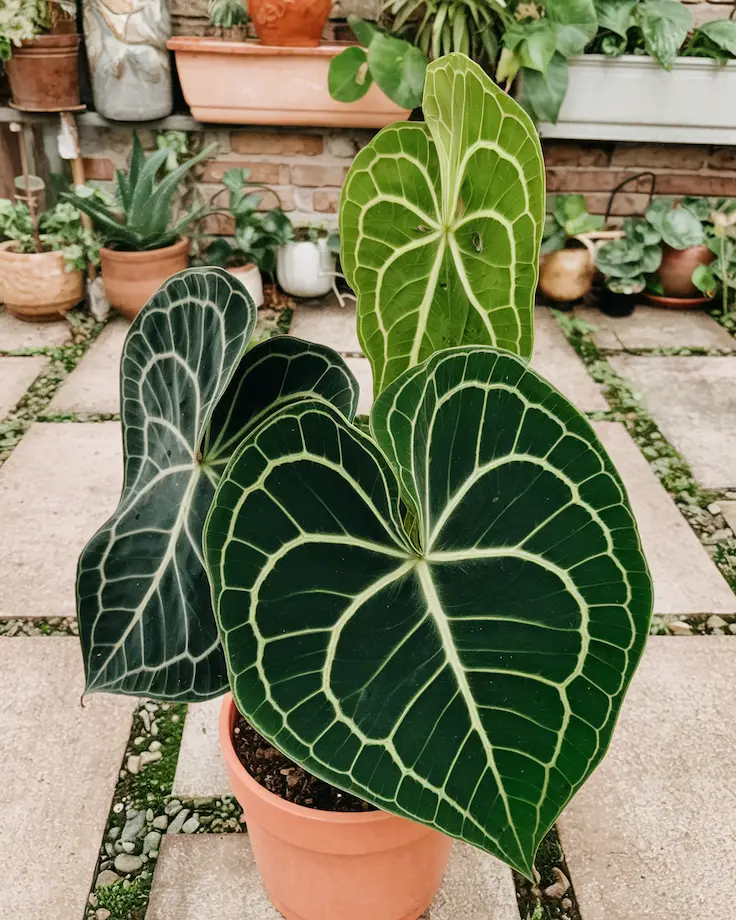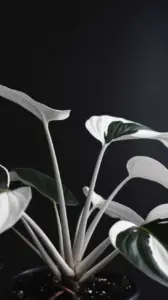Biological Features of Anthurium Clarinervium
Anthurium Clarinervium is a captivating plant native to the rainforests of Mexico. This plant showcases a unique appearance, characterized by its large, heart-shaped leaves. The leaves have prominent white veins that create a striking contrast against the dark green surface. Moreover, the foliage can reach up to 12 inches in length, making it a standout in any indoor garden.
Growth Habit
This species typically grows as an epiphyte in its natural habitat. It thrives in humid conditions and requires well-draining soil to flourish. The growth cycle is perennial, allowing for year-round greenery.
Flowering
Anthurium Clarinervium produces inflorescences, although it may take a few years to flower under cultivated conditions. The flowers are small and arranged on a spadix, surrounded by a modified leaf known as a spathe. The spathe can be white, green, or even reddish depending on its maturity.
| Feature | Description |
|---|---|
| Common Name | Clarinervium Anthurium |
| Leaf Shape | Heart-shaped |
| Leaf Size | Up to 12 inches |
| Light Requirements | Filtered light |
| Watering | Moderate, keep soil moist |
| Humidity Preference | High humidity |
Overall, Anthurium Clarinervium is a remarkable species due to its aesthetic appeal and unique biological features. Understanding these features is essential for successful cultivation and care.

History and Cultural Significance
Anthurium Clarinervium, known for its stunning heart-shaped leaves, has a rich cultural history. This plant originates from Mexico and Guatemala, where it thrives in tropical rainforests. Its unique texture and prominent veins have made it a popular choice among plant enthusiasts.
Cultural Importance
In various cultures, the Anthurium Clarinervium symbolizes hospitality and abundance. It is often used in floral arrangements to convey warmth and welcome. Traditionally, in Mexican culture, this plant is associated with prosperity. People often gift it during significant life events such as weddings or housewarming parties.
Furthermore, Anthurium Clarinervium is sometimes used in medicinal practices. Some indigenous communities leverage its leaves for soothing burns and enhancing relaxation. These uses showcase the plant’s multifunctional role in society.
Art and Design
This striking plant has influenced art and design significantly. Its distinctive shape and vibrant colors inspire artists and designers alike. You can find it featured in paintings, textiles, and home decor. The lush appearance of Anthurium Clarinervium brings a touch of nature indoors, creating an inviting atmosphere.
Moreover, many interior designers highlight this plant in contemporary settings. It enhances aesthetics by adding a pop of color. The ease of care makes it an ideal choice for busy lifestyles.
- Anthurium Clarinervium often appears in tropical-themed decor.
- This plant is recognized for its unique ability to purify air.
- It is commonly used in landscaping and interior spaces.
- Your collection is not complete without this beautiful plant.
- Many gardeners praise its low maintenance requirements.
Overall, the Anthurium Clarinervium enriches both cultural practices and modern design.

Ideal Growing Conditions for Anthurium Clarinervium
To thrive, Anthurium Clarinervium requires a few specific growing conditions. Ensuring that your plant receives the right amount of light, moisture, and temperature makes a significant difference in its overall health. Here are the ideal conditions for optimal growth.
Light Requirements
Anthurium Clarinervium prefers bright, indirect light. Direct sunlight can scorch its leaves. For best results, place the plant near a window where it can receive filtered light. A spot with dappled sunlight is ideal.
Temperature Preferences
This plant thrives in warm environments. Aim for temperatures between 65°F and 80°F (18°C to 27°C). Avoid temperatures below 60°F (15°C) as they can cause stress. Temperature fluctuations should be minimized to promote a stable growth environment.
Humidity Needs
<pAnthurium Clarinervium. Ideally, maintain humidity levels between 60% and 80%. If your home is dry, consider using a humidifier or placing the pot on a tray filled with water and pebbles to increase moisture.
Watering Practices
Water your Anthurium Clarinervium when the top inch of soil feels dry. Ensure that excess water drains to prevent root rot. Generally, this plant enjoys regular watering during the growing season, which is spring and summer.
Soil Requirements
A well-draining soil mix is essential for Anthurium Clarinervium. A blend of potting soil, perlite, and orchid bark works well. This mixture ensures proper aeration and moisture retention.
| Condition | Ideal Setting |
|---|---|
| Light | Bright, indirect light |
| Temperature | 65°F – 80°F (18°C – 27°C) |
| Humidity | 60% – 80% |
| Watering | When top inch is dry |
| Soil | Well-draining mix |
By adhering to these ideal growing conditions, your Anthurium Clarinervium will flourish, showcasing its stunning foliage and unique beauty.

Plant Care and Maintenance
Caring for your Anthurium Clarinervium requires a keen understanding of its needs. This beautiful plant thrives in specific conditions. To ensure its health, provide the right environment and maintenance.
Light Requirements
Anthurium Clarinervium prefers bright, indirect light. Direct sunlight can scorch its leaves. Position it near a window with filtered light. If the leaves turn yellow, it may be receiving too much sun.
Watering Tips
Water your Anthurium Clarinervium when the top inch of soil feels dry. Depending on the humidity, this might be once a week or every ten days. Overwatering can lead to root rot, so ensure proper drainage.
Humidity and Temperature
This plant thrives in high humidity levels. Aim for a humidity level of 60-80%. You can mist the leaves regularly or place a humidifier nearby. Additionally, keep the temperature between 65°F and 80°F (18°C – 27°C). Avoid chilly drafts, as drastic changes can stress the plant.
Fertilizing Your Plant
Feed your Anthurium Clarinervium every 6-8 weeks during the growing season. Use a balanced fertilizer, diluted to half strength. Reduce feeding during the fall and winter months, as the plant enters dormancy.
Pest Management
Check your plant regularly for pests like spider mites and aphids. If you notice any, treat them immediately with insecticidal soap or neem oil. Regular inspection helps prevent infestations.
Repotting
Repot your Anthurium Clarinervium every 2-3 years or when it becomes root-bound. Choose a pot one size larger, with good drainage. Fresh potting mix will supply necessary nutrients and improve drainage.
Common Issues and Solutions
- Yellow Leaves: This indicates overwatering or too much direct sunlight.
- Brown Tips: Low humidity levels may be the culprit.
- Stunted Growth: Insufficient lighting or lack of nutrients can hinder growth.
- Leaf Droop: This often signifies underwatering or a need for a larger pot.
By following these plant care and maintenance tips, your Anthurium Clarinervium will thrive and bring beauty to your space.
Propagation Techniques for Anthurium Clarinervium
Propagating Anthurium Clarinervium can be rewarding and relatively straightforward. This process involves ensuring healthy growth conditions. Start by selecting a mature plant with multiple stems. It is generally best to propagate during the growing season, typically in spring or early summer. This timing allows for optimal growth and recovery.
One common method is division. Carefully remove the plant from its pot, ensuring you do not damage the roots. Gently separate the root ball into sections. Each section should contain at least a few roots and a stem. Now, pot each division in its own container. Remember to use a well-draining potting mix, as this is crucial for preventing rot.
Watering and Care
After potting, water the divisions lightly. Keep them in a location with bright, indirect sunlight. Additionally, maintain high humidity levels around the newly potted plants. Frequent misting or using a humidity tray can help achieve this. Monitor the soil moisture and ensure it does not dry out completely.
Another effective method is propagation through offsets. These are small plants that grow at the base of the parent plant. Simply cut the offset from the main plant, ensuring it has roots. Like with division, plant the offset in a suitable potting mix and follow the same care instructions.
Leaf Cutting Method
Alternatively, you can propagate Anthurium Clarinervium using leaf cuttings. To do this, select a healthy leaf and cut it into sections, each about 4-6 inches long. Each section should have a visible vein for best results.
Place the cuttings in a container filled with moist potting mix. Keep them in a warm, humid environment, and they may develop roots over time. This method takes longer compared to the others, but it can be successful with patience.
In summary, whether you choose division, offsets, or leaf cuttings, choose a healthy plant and provide the right care. Successful propagation will lead to new Anthurium Clarinervium plants to enjoy or share.
Common Problems and Solutions
The Anthurium Clarinervium is a beautiful plant, but it can face some issues. Understanding these challenges helps in providing the right care. Below are common problems along with effective solutions.
Common Problems
- Yellowing Leaves: This can be a sign of overwatering or nutrient deficiency.
- Leaf Spots: Fungal infections often cause leaf spots, particularly in humid environments.
- Pests: Aphids and spider mites may attack, leading to wilting and discoloration.
- Wilting: This problem can occur due to either underwatering or excessive moisture.
Solutions to Common Problems
To combat these issues effectively, consider the following remedies:
| Problem | Solution |
|---|---|
| Yellowing Leaves | Adjust watering schedule, ensuring the top inch of soil dries out between waterings. |
| Leaf Spots | Reduce humidity levels and treat with a fungicide. Remove affected leaves immediately. |
| Pests | Regularly inspect your plant and treat infestations with insecticidal soap. |
| Wilting | Check soil moisture; if dry, water thoroughly. If soggy, allow the soil to dry out. |
By monitoring the Anthurium Clarinervium closely, you can address these issues early. Prompt action ensures the health and beauty of your plant.
Seasonal Care Adjustments
Adjusting care for your Anthurium Clarinervium throughout the seasons is crucial for its health. In winter, reduce watering as the plant enters dormancy. However, don’t let the soil dry completely. During spring and summer, increase watering and humidity. Your Anthurium will thrive with regular moisture. Also, ensure it receives ample indirect sunlight.
Light and Temperature
Provide bright, indirect light for optimal growth. Avoid direct sunlight, as it can scorch the leaves. Ideal temperatures range from 65°F to 80°F (18°C to 27°C). Monitor your plant during colder months, as drafts can be harmful.
Fertilizing
Feed your Anthurium Clarinervium with a balanced, water-soluble fertilizer every 4-6 weeks during the growing season. Reduce or stop fertilizing in the fall and winter months. This will help the plant conserve energy during dormancy.
- Spring: Increase watering and humidity.
- Summer: Regular feeding every 4-6 weeks.
- Fall: Decrease watering slightly.
- Winter: Minimal watering; avoid overwatering.
Microclimate Setup Tips
Creating the ideal microclimate for your Anthurium Clarinervium is essential for its growth and health. This tropical plant thrives in conditions that mimic its natural habitat. Here are some tips to help you establish the perfect environment:
Temperature and Humidity
- Maintain a temperature range between 65°F and 80°F (18°C to 27°C).
- Humidity levels should be kept above 50%. Consider using a humidifier or misting the leaves to achieve this.
- Avoid cold drafts as they can stress the plant.
Light Requirements
- Provide bright, indirect sunlight. Direct sunlight can scorch the leaves.
- If natural light is limited, consider using grow lights to supplement.
Watering Practices
- Water when the top inch of soil feels dry. Over-watering leads to root rot.
- Ensure the pot has proper drainage to prevent standing water.
By following these tips, you can create a nurturing microclimate for your Anthurium Clarinervium. This ensures it flourishes beautifully in your home.
Frequently Asked Questions
Anthurium Clarinervium is popular for its stunning heart-shaped leaves and unique veining. Below are some common questions regarding this beautiful plant.
What is the ideal light for Anthurium Clarinervium?
Anthurium Clarinervium thrives in bright, indirect light. Too much direct sunlight can scorch the leaves. Therefore, placing it near a north or east-facing window works best.
How often should I water my Anthurium Clarinervium?
Water the plant when the top inch of soil feels dry. Generally, this may be every 1 to 2 weeks, depending on humidity and temperature. Be careful not to overwater, as this can lead to root rot.
What soil mix is best for Anthurium Clarinervium?
A well-draining potting mix works best. Aim for a mix containing peat, perlite, and orchid bark. This promotes healthy root growth and prevents waterlogging.
Is Anthurium Clarinervium pet-friendly?
Unfortunately, Anthurium Clarinervium is toxic to pets if ingested. Thus, it’s crucial to keep this plant out of reach from curious cats and dogs.
By following these care tips, you will find that the Anthurium Clarinervium thrives beautifully in your home.
Summary and Recommendations
Anthurium Clarinervium, known for its striking heart-shaped leaves, thrives in indoor settings. Its unique foliage adds elegance to any space. This plant prefers bright, indirect light, ensuring vibrant growth. Additionally, maintaining humidity levels around 60% helps the Anthurium flourish. Watering should occur when the top inch of soil feels dry. Overwatering can lead to root rot, so careful monitoring is essential.
It’s beneficial to use a well-draining potting mix. This allows for proper aeration and moisture retention. Fertilizing with a balanced liquid fertilizer every 4-6 weeks promotes healthy growth. Regular leaf cleaning keeps the plant free from dust, enhancing its photosynthesis efficiency.
For best results, consider repotting every couple of years. This ensures the Anthurium has adequate space for root development. Ultimately, with the right care, your Anthurium Clarinervium will thrive, bringing beauty and freshness to your home.
</p






